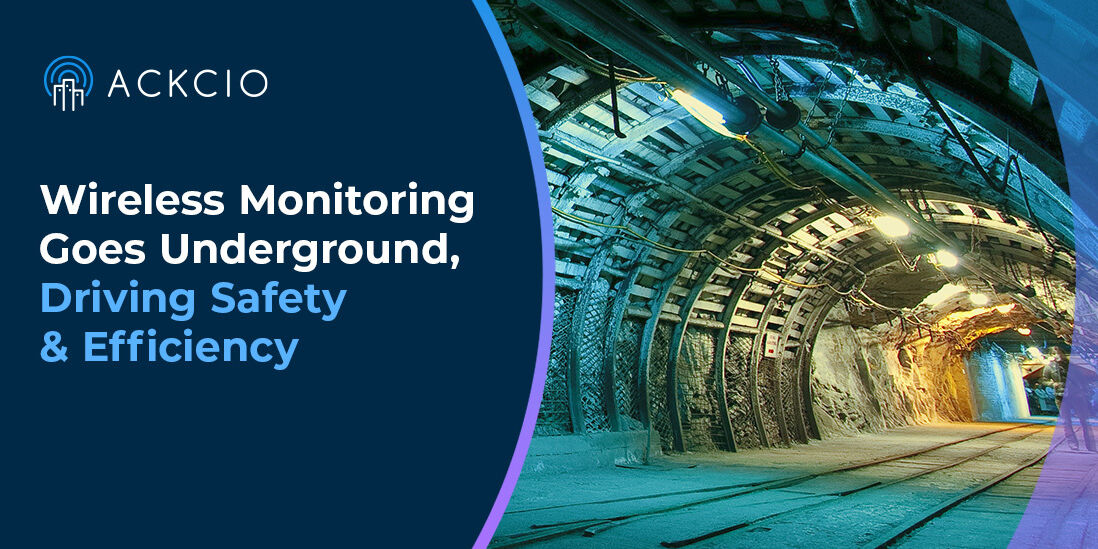Wireless Monitoring Goes Underground, Driving Safety & Efficiency

Mines are one of the most complex, high-risk types of projects for geotechnical and structural monitoring.
There’s often a wide variety of monitoring needs for different site features, from tailings dams and tunnels to infrastructure and open pits, often spread over a large area. Mines are frequently located in remote, hard-to-reach places. And getting readings from underground sensors to the surface is an ongoing challenge.
Legacy monitoring technology for mines meant cables, often kilometres of them, hardwiring a network of data loggers attached to sensors. These readings had to be manually collected or hardwired into a gateway device at the surface.
“Most mines don’t have network connectivity underground,” says Shaun Ahern, Global Sales Director at Ackcio, a global provider of long-range wireless data acquisition systems for industry. “They always have to get to that endpoint, which is the opening of the mine, to get to the gateway to transmit that data. Otherwise, they have to send workers down to take readings.”
But a new generation of wireless technology is empowering mines to go deeper, safer without the burden of hardwiring, overcoming the traditional limitations of gathering data underground. And unlike old manual systems, which only offer a snapshot-in-time reading, these new tools provide rich, ongoing, real-time data.
“The mining industry has been a progressive adopter of powerful new digital and wireless tools,” Shaun says. “Safety and productivity are of primary importance to any mine. The access to data helps boost both and avoid potential stop-work orders or accidents, which can be detrimental.”
Safer is Also More Productive
In 2021, Ramjack, a full-service technology implementation partner to the mining industry, was looking to automate readings for a client operating an underground gold and copper mine in Eastern Europe. The client wanted to limit workers making the trip underground to take manual readings by automating data transmission from multi-point borehole extensometers (MPBXs) to its existing WiFi network at the surface.
The challenge?
Most wireless solutions use a star topology in which each sensor must “speak” directly to the gateway at the surface, significantly limiting the distance data can be transmitted underground.
Ramjack wanted to go further. They ultimately chose Ackcio for the project, installing Ackcio Analogue Nodes (BEAM-AN-S4), which send readings wirelessly to the Ackcio Gateway (BEAM-GW).
“Ackcio is making it easy to get reliable, real-time data that previously would have been too difficult to access from a cost or infrastructure perspective,” says Mike Jackson, President and CEO at Ramjack. (Click here to read the entire case study.)
Going Further
So how does Ackcio transmit data wirelessly over the long range?
It all comes down to its unique, patented, mesh communication system based on years of research in the wireless networking field. Its nodes can transmit data up to 5 kilometres in ideal conditions.
Plus, the Ackcio Beam can make up to 12 “hops” between nodes to reach the gateway.
“That means we can go really deep and far,” says Shaun Ahern. “Whereas other systems are limited by a single communication route to the gateway, we offer a highly extendable data pipeline that goes further than any other wireless technology on the market.”
Plus, it allows for easy scalability to keep pace with a mine’s expanding operations or monitoring needs.
Beyond Tunnels
Of course, tunnels are just one aspect of mining infrastructure. Tailings dams and open-pit mines also need to be monitored for signs of risk or failure. And mine owners and operators are under a lot of pressure to improve their risk management to meet with the new Global Industry Standard on Tailings Management (GISTM) and other regulations.
At the Kalgoorlie Gold Processing Facility in Australia, manual monitoring of its tailings dam was cost-prohibitive and impractical due to the infrequency of readings, the dam’s remote location and the vast project site. Again, Ackcio was a good solution.
Its nodes don’t need cabling or external power supply – their ultra-low power consumption means they can run on the same batteries for years. And bidirectional communication means that operators can remotely adjust the reading frequency as needed.
Unlike with a star system where, if there’s an obstruction or interference between node and gateway, the reading is lost or can only be manually downloaded from the node itself, Ackcio’s mesh topology offers multiple data transmission paths from nodes to the gateway device, ensuring no data is lost, even in tough, remote settings.
And the Ackcio Beam is product agnostic, integrating with multiple sensors and software platforms.
“We’ve made our system as seamless as possible,” Shaun says. “It’s plug-and-play for all boots on the ground.”
Data in Real-Time
Along with limiting the number of trips by workers going underground or to high-risk areas of a mine site, safety in this high-stakes industry corresponds to data.
The best way to keep workers and assets safe is to have regular, real-time sensor readings providing a current and ongoing picture of what’s happening. Mine operators can quickly identify and investigate anomalous readings and respond in real-time to potentially dangerous movement related to such concerns as displacement or groundwater activity.
“Now the operators have a complete understanding of rock movements underground,” Shaun says.


